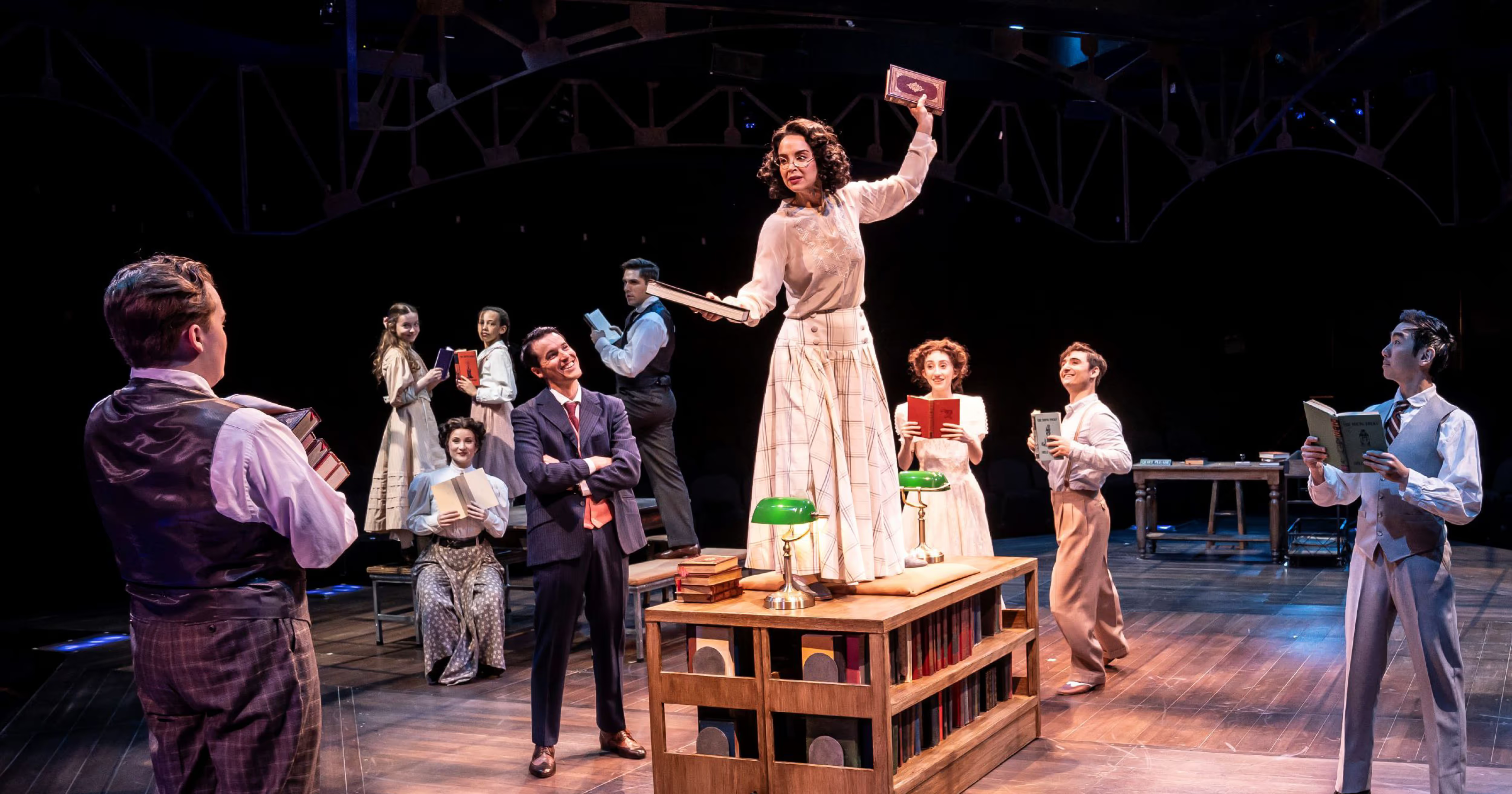The Music Man at Marriott knows the territory
A sparkling revival lets us believe in the storybook premise of a classic American musical.
In the opening scene of Meredith Willson’s The Music Man at Marriott Theatre, a train car full of traveling salesmen showcase their talent and precision as they fast-talk and sing their way through the opening number, “Rock Island” (aka the “Ya gotta know the territory” song). The salesmen, each identified by a different company name on their suitcase props, perform the song with rhythmic perfection and aplomb, setting the stage for the high production values, dramatic flair, and entertaining song and dance that continue throughout the show. The train noises (designed by Michael Daly) are perfect in their rhythmic hissing and sputtering, doing justice to the book and lyrics of this production.
It’s one thing to roll out an old chestnut like The Music Man and amiably work through the show, as many companies have done. But Marriott’s production, directed and choreographed by Katie Spelman, captures and embodies the earnest levity of this show, allowing the audience to believe in the premise: that the kids whose parents were fleeced by the slimy title character, Professor Harold Hill (KJ Hippensteel), could provide some semblance of a band concert after weeks of gallivanting around town and not practicing or giving their instruments any thought at all.
The charm of this production lies in its ability to immerse the audience in its illusions. With its earnest “building it and they will come” approach and the thoroughly contemporary concept of acting “as if,” the show enrolls the audience, the townspeople, the music teacher, and the children of River City in its illusions. By the time the storybook ending comes, we find ourselves believing that Professor Hill’s new teaching methods might just have worked, a testament to the production’s magical suspension of disbelief.
Spelman’s directorial choices make some of the numbers positively delightful. They show the power of extraordinary stagecraft. Using a diagonal setup for “Rock Island” showed off the best of theater in the round. “The Wells Fargo Wagon,” complete with a motorized wooden wagon traveling down the aisle and onto the stage, is captivating. With its wooden library tables and benches, multiple leveled choreography, masterful use of props, and beautiful singing and acting, “Marian the Librarian” (sung by Hippensteel’s Hill to Alexandra Silber’s Marian Paroo) is utterly charming. And the moment of placing a line of lanterns onstage (that had been hung behind the seats around all sides of the theater previously) to form a footbridge for the back-to-back renditions of “Till There Was You” and the reprises of “Goodnight, My Someone” and “Seventy-Six Trombones“ was a surprising and breathtaking transformation. Scenic designer Collette Pollard deserves a “bravo!” for these moments.
The costumes, designed by Raquel Adorno, deserve a mention, too. The mixed plaids and patterns of incredibly well-crafted period costumes in the first act gave way to a slightly more colorful palette for the second act’s “ice cream social” without losing the original style and patterns. Specifically, the use of Professor Hill’s pink vest as a through line (he is, after all, a showman throughout) and the addition of pink, orange, blue, and purple in the costuming, as well as a riot of tiny hats with floral decorations, added to the overall enchantment of the show.
In supporting roles, Kai Edgar and Michael Earvin Martin shine as Winthrop Paroo and Marcellus Washburn. Melaine Loren makes a delightful peacocking mayor’s wife as Eulalie Mackecknie Shinn. In particular, Loren has a lovely breaking-the-fourth-wall moment as she instructs a fellow player to “keep your face to the audience” during a dance rehearsal scene, turning her head 360 degrees in a nod to the in-the-round format at Marriott Theatre.
The more troubling aspects of this show are still present here: namely, the conservatism and classism, the “othering” of a nonverbal child, its celebration of capitalism, entrepreneurship, and hucksterism, and the fairy-tale ending with an old maid and the shyster salesman-turned-upstanding citizen. However, multicultural casting by Spelman helps to abate the typical utter whiteness of 1912 Iowa and the show itself. The fact that the cast seems to have just as much fun as the audience engaging in the production helps push away the more problematic themes.
In a program note, Spelman asserts, “The idea that love, community, and redemption are all inextricably intertwined with one another is a wonderful reminder in these turbulent times.”
Marriott’s The Music Man does just this. Casting a magical net over its audience, the show lets us believe that magic can happen, that the slimy salesman can be redeemed, and that we can be touched and our hearts can be filled with music, dance, and live performance.











